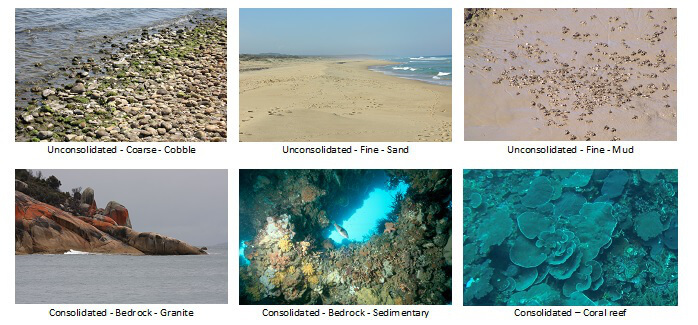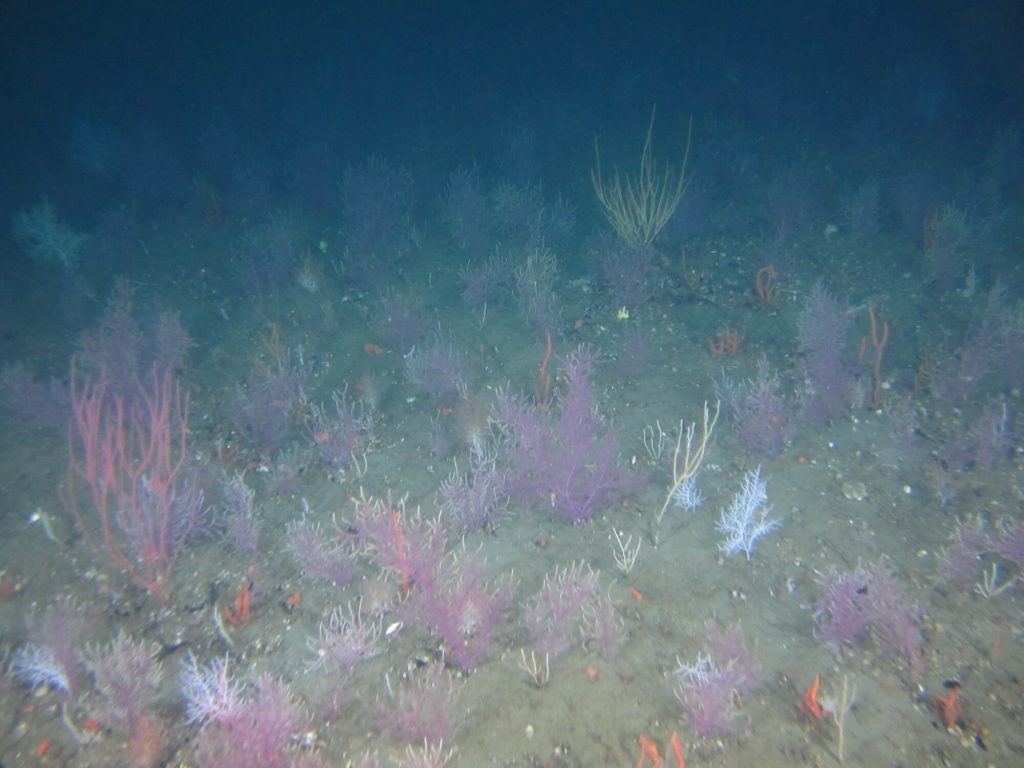The CBiCS substrate component provides a classification of the physical composition of the seabed. This information has some redundancy with the geoform component, however there are advantages that either component can be used in isolation of each other, or used to together to determine origin where it is not readily observed from underwater imagery. The CBiCS substrate component is based on the CMECS standard, with a key modification that substratum origin (the entry point to CMECS) is removed from the CBiCS hierarchy and included as a separate descriptor. Substratum origin (e.g. geological versus biologic) is often difficult to determine from imagery.

Substrate Hardness
In CBiCS, a new category of substratum hardness was added to the top level of the hierarchy. This essentially divides soft sediments and hard substrata and is also a top-level distinction withing the biotic component hierarchy. Hardness is measurable from acoustics and provides a key high-level split that is directly linked to biota (Kloser et al. 2001 (PDF, 10MB), Kloser 2007 (PDF, 16MB), Kloser et al. 2010 (PDF, 1MB)). Hardness can be quantitative where data exist, or qualitative. Multibeam acoustic surveys are data rich and often the first indications of seabed habitat in new areas, particularly in the deep sea. As the national coverage of multibeam acoustics is expanded, and the tools for the analysis of backscatter improve, CBiCS recognises the potential value of this large data source to assist (and automate) classification of large areas.
The division between stable, reef-like and mobile sediment-like properties of unconsolidated boulder, cobble and pebble substrata is dependent on the level of packing and bedding, disturbance levels from wave and currents and stabilisation or destabilisation of attached biota. Consequently, coarse sediments such as cobble and pebble can be classified within ‘hard’ substrata where they provide stable surfaces of biological attachment or be classified within ‘soft’ substrata where they are mobile and unconsolidated.
A key challenge to substrate classification is presented by sand-inundated hard substrata (i.e. ‘soft’ veneer over ‘hard’ substrate). CBiCS includes an ‘veneer substratum’ to classify and map complexes of hard substrata with soft sediment veneer, such as pavement reef and rhodolith beds that have a veneer of soft sediments. Similarly, the geoform component includes veneer reef categories. Multiple lines of evidence are required to identify this class, such as repeated observations over time, sub-bottom acoustic echograms and the presence of indicative species such as erect sessile invertebrates that attache to hard substrata but are protruding through soft sediments.
Another major class added to the CBiCS substrate component is patchy reef in sediment. This group includes clusters of rock or hard surface outcrops surrounded by soft sediments or gravel where it is inappropriate to be classified as solely sediments or solely reef.

It should be noted that hard substrates include consolidated and unconsolidated surfaces that typically enable colonisation of sessile biota, although some hard substrata may be uncolonised due to scouring or other disturbances. Consolidated substrate classes include geologic bedrock and megaclasts. Unconsolidated hard substrata include beds of coarse particulates (i.e. gravel), such as boulders, cobble, pebble, shell rubble, shell hash and woody debris. Biogenic hard substrate includes coral reefs, shell reefs and woody debris. Anthropogenic hard substrates include materials of rock (rip rap), wood (e.g. piling, decking), concrete (such as in breakwalls) and metal (e.g. sheet piling). Wrecks, including ships, planes and other vehicles, are listed as a separate substratum class as they are comprised of multiple types of materials and usually occur as a discrete biotope and mapping entity.
Substrate Classes
Classification of soft substrata inevitably involves the use of sediment grain size indicators and the standardisation of their use requires training and supervision. Definitions are important and in application, CBiCS developers have found that over time and with checks in place, there is good conformance among multiple users.
Users are encouraged to study the definitions (as adopted from CMECS) as these can be initially confusing (e.g. ‘shelly sand’ versus ‘sandy shell’). Classification projects should define what levels of the hierarchy can be expected to reliably classified given the parameters of image quality and skill levels and what supervision is appropriate.
Substrate Hierarchy Explorer
The substrate component hierarchy can be explored by clicking here.
Definitions
CBiCS will update and maintain and update a dictionary of standard terminology used in each component.
